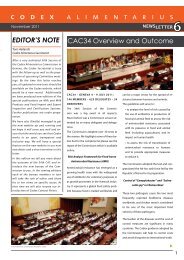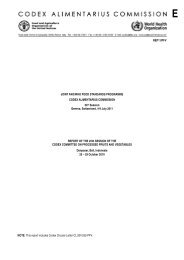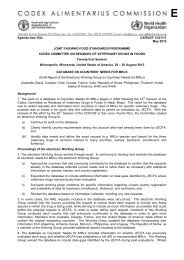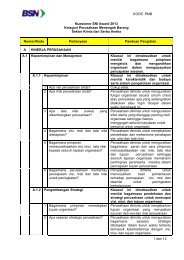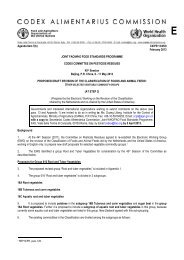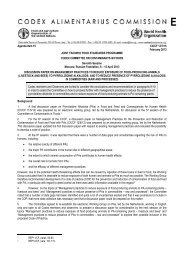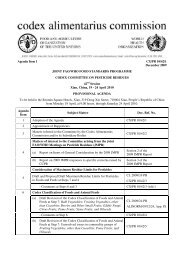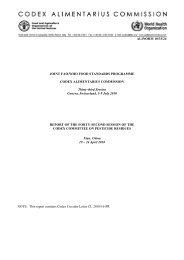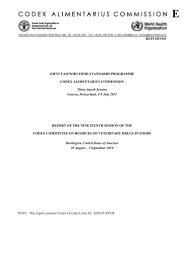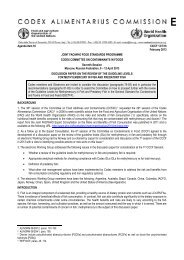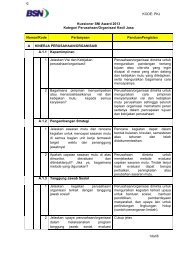alinorm 10/33/41 - CODEX Alimentarius
alinorm 10/33/41 - CODEX Alimentarius
alinorm 10/33/41 - CODEX Alimentarius
You also want an ePaper? Increase the reach of your titles
YUMPU automatically turns print PDFs into web optimized ePapers that Google loves.
ALINORM <strong>10</strong>/<strong>33</strong>/<strong>41</strong>42APPENDIX IIIPROPOSED DRAFT CODE OF PRACTICE FOR THE PREVENTION AND REDUCTION OFETHYL CARBAMATE CONTAMINATION IN STONE FRUIT DISTILLATESINTRODUCTION(AT STEP 3 OF THE PROCEDURE)1. Ethyl carbamate is a compound that occurs naturally in fermented foods and alcoholic beverages such asbread, yoghurt, soy sauce, wine, beer, and particularly in stone fruit spirits and stone fruit marc spirits, mainlythose made from cherries, plums, mirabelles and apricots.2. Ethyl carbamate can be formed from various substances inherent in food and beverages, includinghydrogen cyanide (or hydrocyanic acid), urea, citrulline, and other N-carbamyl compounds. Cyanate is probablythe ultimate precursor in most cases, reacting with ethanol to form ethyl carbamate. Therefore measures shouldfocus on hydrocyanic acid and other precursors of ethyl carbamate.3. Ethyl carbamate is genotoxic and a multisite carcinogen in animals and is probably carcinogenic tohumans.4. Stone fruit and stone fruit marc spirits, in particular, contain ethyl carbamate in manyfold higherconcentrations than other fermented foods and beverages. In stone fruit distillates (stone fruit spirits and stonefruit marc spirits) ethyl carbamate can be formed from cyanogenic glycosides that are natural constituents of thestones. When mashing the fruit, the stones may be damaged and cyanogenic glycosides from the stones may comeinto contact with enzymes in the fruit mash. Cyanogenic glycosides are then degraded to hydrocyanicacid/cyanides. Hydrocyanic acid may also be released from intact stones during a prolonged storage of thefermented mash. The presence of copper ions before the distillation will inhibit the co-destillation of hydrocyanicacid by binding the cyanide to an insoluble salt. Otherwise, during the distillation process hydrocyanic acid maybe enriched in all fractions. Cyanide in the distillates may be oxidized to cyanate, which can react with ethanol toform ethyl carbamate. The presence of copper ions in the distillate promotes this reaction which leads to increasedlevels of ethyl carbamate. Certain other environmental conditions such as exposure to light promote the formationof ethyl carbamate in the distillate.5. Although no strong correlation between the level of hydrocyanic acid and ethyl carbamate has beenestablished so far, it is evident that under certain conditions high concentrations of hydrocyanic acid lead to higherlevels of ethyl carbamate. A potential increase in ethyl carbamate formation has been associated with levels at orabove 1 mg/l hydrocyanic acid in the final distillate.SCOPE AND DEFINITIONS6. This Code of Practice intends to provide national and local authorities, manufacturers and other relevantbodies with guidance to prevent and/or reduce formation of ethyl carbamate in stone fruit spirits and stone fruitmarc spirits. Ethyl carbamate formation in other alcoholic beverages and foods is not covered in this Code.7. The definitions below apply to this Code:(a)(b)(c)(d)Stone Fruit means a fruit which is produced on trees belonging to the genus Prunus of the rosefamily (Rosaceae).Distillates means alcohol-rich products obtained after the distillation process.Stone Fruit Spirits means the distillates for consumption, obtained after distillation process of themash prepared by fermentation of crushed stone fruit at first hand or secondly by maceration ofcrushed and/or whole stone fruit in alcoholic beverages.Stone Fruit Marc Spirits means the distillates for consumption, obtained after distillation processof fermented stone fruit marc (pomace).



